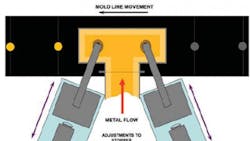Increasing Production by Applying Multiple Pouring Strategies
The competitive nature of today’s global market for cast components has challenged us to examine all the different ways that we produce our castings. Ever-increasing quality and safety standards create new benchmarks for more precise, repeatable processes, requiring us to control and automate all facets of the foundry.
New generations of automated pouring systems have been developed to meet this need. The advent of intelligent sensors and personal computers with sophisticated algorithms makes it possible to adapt to the many variables associated with holding and pouring iron. Numerous foundries around the world have adopted these new pouring technologies, producing castings with a great degree of accuracy, repeatability and reliability.
The growth today is happening thanks to ever-increasing vertical molding speeds and the ability to meet acceptable production rates with an automated pouring device. One challenge for pouring system manufacturers is to be able to deposit metal into the mold within the cycle time offered by the molding machine. There are two basic avenues of thought on how to accomplish this task.
Series pouring requires the molding machine to squeeze a mold, index and stage it, and squeeze the second mold before both are transported down the line. This presents two molds to the pouring device at once, thus increasing available pouring time and mold production.
Pouring two molds is simple with the use of a pouring concept like Multi-Pour™ Technology (patent-pending.) Two servo-driven stopper mechanisms align in one launder or vessel and simultaneously dispense metal within the two molds. This requires semi-fixed, mold-tomold spacing as the pouring nozzle location is fixed. Instead of using two separate nozzles, a mono-block concept for the nozzle provides a single component with accurate orifice positioning for a given mold arrangement.
Large changes in mold thickness can be addressed with a nozzle change having a different orifice offset distance. Should this distance increase greatly, each stopper mechanism can adjust in each of its axes to make the realignment. In the case of series pouring, the requirement is to limit the differences in mold thickness to minimize variations in nozzle changes (see Figure 1). In the worst case, this may lead to differing sand-to-metal ratios. Keep in mind, this concept is most beneficial when used on molds with pouring times longer than available mold cycle time.
The ability to pour two sequential molds simultaneously helps to fill the molds in a more reasonable manner and provides flexibility for maximizing production yields.
Parallel pouring is a departure from typical vertical molding, as it requires a wider sand cake to house two patterns, similar or not. The patterns are mounted side-by-side so that when a single cake is squeezed, two molds are produced. The depth of the sand mold produced does not change. It appears that a range of differing patterns, possibly with different pour weights, may have similar sprue locations, thereby allowing for a fairly consistent distance between sprue cups (see Figure 2).
There are several advantages to this concept. Molding machine cycle rates can be reduced for a large increase in production. Because the molding machine is making impressions for each mold and they are being poured simultaneously, it is possible to make 300 molds per hour while filling double that amount. A single pouring device with two stopper rods located along the parting line of the mold can be used. As there are two molds side-by-side, the cake thickness can be fine-tuned to the best fit for the sand-to-metal ratios required. Similar to series pouring, typical mold tracking for sand compatibility may be employed.
As the mold thickness is not disrupted, in-mold cooling remains similar to what is expected on a single-pour system and the length of the cooling line is not affected.
Filling molds rapidly has not been an issue in the past. The challenge is to be able to fill them accurately and repeatably and to do so without sacrificing mold yield. Both concepts eliminate this current dilemma by presenting two molds available for simultaneous pouring. It is now in the realm of possibility to see pouring systems capable of filling more than 800 molds per hour on a single mold line.
In conclusion, no matter which method you choose – single- or multi-pour, series or parallel – automating your foundry operations increases worker safety by helping to distance operators away from the most hazardous areas close to molten metal. By combining safer automated operations and advanced, high-production technology, foundries around the world can ensure they have the competitive edge by choosing automated pouring systems.
William Pflug is the Manager of Automated Pouring Systems at Inductotherm Corp. Visit www.inductotherm.com
